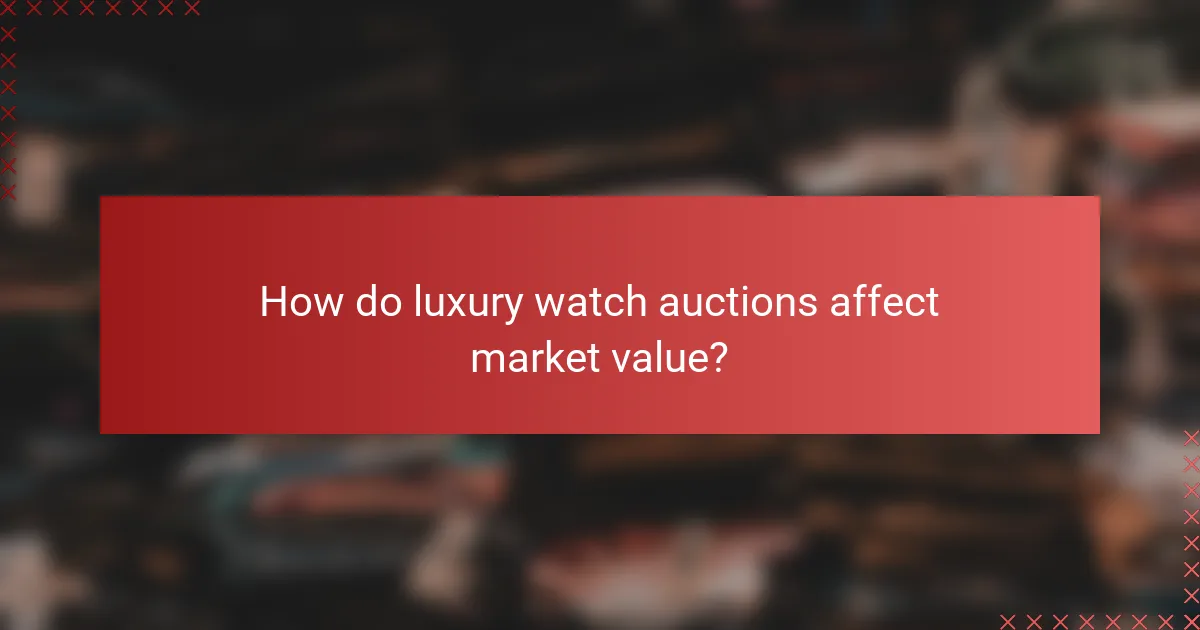The heritage of luxury watches plays a crucial role in determining their value and collectibility, as it encompasses brand reputation, historical significance, and exceptional craftsmanship. Collectors often seek timepieces from renowned brands with rich histories, leading to increased demand and higher prices. Understanding the factors that influence collectibility, such as rarity and condition, can empower enthusiasts to make informed decisions and enhance their collections.

How does luxury watch heritage influence value?
Luxury watch heritage significantly impacts a watch’s value by establishing its brand reputation, historical significance, and craftsmanship. Collectors and enthusiasts often prioritize these elements, leading to higher demand and prices for watches from reputable brands with rich histories.
Historical significance of brands like Rolex
Brands like Rolex have built a legacy that enhances their value through historical significance. Founded in the early 20th century, Rolex pioneered innovations such as the waterproof watch and the automatic movement, which have become industry standards. This historical context not only elevates the brand’s prestige but also makes its timepieces highly sought after.
The connection to significant events, such as Rolex watches being worn by explorers and athletes, further cements their status. Collectors often pay a premium for models linked to these milestones, reflecting the brand’s storied past.
Impact of craftsmanship on pricing
The craftsmanship of luxury watches plays a crucial role in determining their pricing. High-quality materials, intricate movements, and meticulous assembly contribute to the overall value. For instance, watches made with precious metals or featuring complex complications tend to command higher prices.
Additionally, brands that emphasize hand-finished components and limited production runs often see a corresponding increase in value. Collectors appreciate the artistry and skill involved, making these timepieces more desirable in the market.
Collector demand for vintage models
Collector demand for vintage luxury watches has surged in recent years, significantly influencing their market value. Vintage models, especially those from prestigious brands, often fetch prices well above their original retail value due to their rarity and historical importance. For example, certain vintage Rolex models can sell for hundreds of thousands of dollars at auction.
Factors driving this demand include nostalgia, the allure of unique designs, and the investment potential of these timepieces. Collectors often seek out models that are no longer in production, as these can appreciate over time, making them attractive assets in addition to being functional watches.

What factors determine collectibility in luxury watches?
Collectibility in luxury watches is influenced by several key factors, including rarity, brand reputation, and the condition of the timepiece. Understanding these elements can help collectors make informed decisions and enhance the value of their collections.
Rarity and limited editions
Rarity is a significant driver of collectibility in luxury watches. Limited edition models, often produced in small quantities, tend to attract more attention and command higher prices in the market. Collectors often seek out pieces that are hard to find, as their scarcity can lead to increased demand.
For example, a watch that is part of a limited run of 100 pieces may be more desirable than a model that is mass-produced. When evaluating rarity, consider the total production numbers and any unique features that set a model apart.
Brand reputation and legacy
The reputation of a watch brand plays a crucial role in its collectibility. Established brands with a long history, such as Rolex, Patek Philippe, and Audemars Piguet, often have a legacy that enhances the desirability of their watches. A strong brand reputation can lead to higher resale values and a more robust collector community.
Additionally, brands that have been involved in significant historical events or have associations with celebrities can further increase the allure of their timepieces. Collectors should research a brand’s history and its impact on the watchmaking industry to gauge potential collectibility.
Condition and provenance
The condition of a luxury watch is paramount to its collectibility. Timepieces that are well-maintained, with original parts and minimal wear, typically fetch higher prices. Collectors should look for watches with complete documentation, including service records and original packaging, as these factors contribute to overall value.
Provenance, or the history of ownership, can also enhance a watch’s appeal. A watch previously owned by a notable individual or featured in a significant event can command a premium. When considering a purchase, verify the watch’s history and ensure it has been properly cared for to maximize its collectibility.

Which luxury watch brands have the strongest heritage?
The luxury watch brands with the strongest heritage include Rolex, Patek Philippe, and Audemars Piguet. These brands have established themselves through a combination of historical significance, craftsmanship, and innovation, making them highly sought after in the collector’s market.
Rolex’s historical milestones
Rolex has a rich history marked by several significant milestones that have solidified its status in the luxury watch industry. Founded in 1905, Rolex was the first brand to introduce the waterproof wristwatch with the Oyster case in 1926, which set a new standard for durability and functionality.
Additionally, Rolex’s pioneering work in automatic movements and the introduction of the Datejust in 1945 contributed to its reputation for precision and reliability. These historical achievements not only enhance Rolex’s brand value but also increase the collectibility of its timepieces.
Patek Philippe’s craftsmanship legacy
Patek Philippe is renowned for its exceptional craftsmanship and attention to detail, which has been a hallmark of the brand since its founding in 1839. The brand is known for producing some of the most complicated mechanical watches in the world, often taking years to create a single piece.
This dedication to artistry and quality has made Patek Philippe watches highly coveted among collectors, with many pieces appreciating significantly in value over time. The brand’s commitment to tradition and innovation ensures its legacy continues to thrive in the luxury market.
Audemars Piguet’s innovation history
Audemars Piguet has a storied history of innovation, particularly with the introduction of the Royal Oak in 1972, which revolutionized the luxury sports watch segment. This bold design broke conventions and established a new category of luxury timepieces that combined elegance with sporty functionality.
The brand’s focus on pushing the boundaries of watchmaking has led to numerous technological advancements, including the development of ultra-thin movements. Collectors value Audemars Piguet not only for its iconic designs but also for its commitment to innovation and quality craftsmanship.

How do luxury watch auctions affect market value?
Luxury watch auctions significantly influence market value by setting new price benchmarks and generating heightened interest among collectors. The results of these auctions can lead to increased demand and perceived value for specific brands and models, impacting their collectibility.
Record-breaking sales at Sotheby’s
Sotheby’s is known for its record-breaking sales of luxury watches, often showcasing rare and unique pieces that attract high bids. For instance, certain models from brands like Patek Philippe and Rolex have sold for millions of USD, establishing new market standards. These high-profile transactions not only elevate the value of the sold watches but also enhance the desirability of similar models.
Collectors and investors closely watch these auctions, as they can signal trends in the luxury watch market. A record sale can spark interest in lesser-known models from the same brand, creating a ripple effect that boosts their market value.
Influence of auction houses on brand perception
Auction houses like Sotheby’s and Christie’s play a crucial role in shaping brand perception within the luxury watch market. Their curation of high-quality, rare timepieces enhances the prestige of the brands they represent, making them more appealing to collectors. This elevated status can lead to increased prices and demand for watches from those brands.
Moreover, the marketing strategies employed by these auction houses, including expert testimonials and detailed histories of the watches, contribute to a narrative that enhances the perceived value. Collectors often seek pieces that have been featured in prestigious auctions, believing that their provenance adds to their worth.

What are the trends in luxury watch collecting?
Luxury watch collecting is increasingly influenced by digital platforms and a growing focus on sustainability. Collectors are now more informed and connected, leading to shifts in demand and value perceptions.
Growth of digital platforms like Chrono24
The rise of digital platforms such as Chrono24 has transformed how collectors buy and sell luxury watches. These platforms offer vast selections, competitive pricing, and user-friendly interfaces, making it easier for enthusiasts to find rare pieces.
Additionally, online marketplaces provide detailed information, including historical prices and trends, which help collectors make informed decisions. Buyers can compare models and access a global market, often leading to better deals than traditional retail channels.
Emergence of sustainable luxury brands
As consumers become more environmentally conscious, sustainable luxury watch brands are gaining traction. These brands prioritize ethical sourcing, eco-friendly materials, and transparent manufacturing processes, appealing to a new generation of collectors.
For instance, brands that utilize recycled metals or innovative materials like bio-sourced plastics are increasingly popular. Collectors are not only looking for aesthetic value but also for pieces that align with their values, which can enhance the perceived worth of these watches.

How can collectors assess the value of their watches?
Collectors can assess the value of their watches by considering several key factors, including brand reputation, rarity, condition, and market demand. Understanding these elements helps in determining both current worth and potential future appreciation.
Brand Reputation
The brand of a watch significantly influences its value. Renowned luxury brands like Rolex, Patek Philippe, and Audemars Piguet often command higher prices due to their prestige and history. Collectors should research the brand’s heritage and reputation within the watch community to gauge potential value.
Additionally, limited editions or models associated with notable events can enhance a brand’s desirability. For instance, a watch linked to a famous personality or a significant historical moment may be more valuable than standard models.
Rarity and Limited Editions
Rarity is a crucial factor in watch valuation. Limited editions or discontinued models tend to appreciate more over time due to their scarcity. Collectors should look for production numbers, as watches produced in low quantities are often more sought after.
For example, a watch with only a few hundred pieces made can be significantly more valuable than a mass-produced model. Keeping an eye on auction results can provide insights into how rarity affects market prices.
Condition and Authenticity
The condition of a watch plays a vital role in its value. Watches that are well-maintained, with original parts and minimal wear, typically fetch higher prices. Collectors should assess the watch’s mechanical condition, appearance, and any service history.
Authenticity is equally important; counterfeit watches can severely diminish value. Collectors should ensure they have proper documentation and verify the watch’s authenticity through reputable sources or experts.
Market Demand and Trends
Market demand fluctuates based on trends, economic conditions, and collector interest. Staying informed about current trends can help collectors make educated decisions about buying or selling. Following watch forums, attending auctions, and reading industry publications can provide valuable insights.
For instance, certain styles, such as vintage divers or pilot watches, may experience surges in popularity, impacting their value. Collectors should be aware of these trends to capitalize on potential appreciation.
